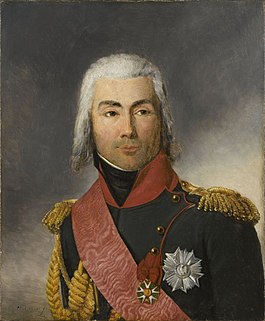 W
WJean-Baptiste Bessières, 1st Duke of Istria was a French military commander and Marshal of the Empire who served during both the French Revolutionary Wars and the Napoleonic Wars. His younger brother, Bertrand, followed in his footsteps and eventually became a divisional general. Their cousin, Géraud-Pierre-Henri-Julien, also served Emperor Napoleon I as a diplomat and imperial official.
 W
WAuguste-Jean-Gabriel, comte de Caulaincourt was a French cavalry commander who rose to the rank of general during the First French Empire. He was the son of French general and senator Gabriel-Louis de Caulaincourt and younger brother of general and diplomat Armand Augustin Louis de Caulaincourt.
 W
WJean-Baptiste Cervoni became a general officer in the French army during the French Revolutionary Wars and was killed in action in 1809 during the Napoleonic Wars.
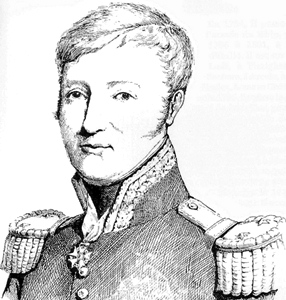 W
WVital Joachim Chamorin was a French general officer who was known for commanding the 26th French Dragoons Regiment during the Peninsular War. He was killed at the Battle of Campo Maior while fighting against the British light cavalry of William Carr Beresford.
 W
WBaron Victor Frédéric Chassériau was a French general of the Napoleonic Wars, who served as chief of staff to general Comte Milhaud.
 W
WAuguste François-Marie de Colbert-Chabanais, Comte de l'Empire joined the French army during the French Revolutionary Wars. He became a general officer of cavalry during the Napoleonic Wars and fought in a number of major battles under Emperor Napoleon I of France in 1805-1807. He was killed by a long range shot fired by a British rifleman during the Peninsular War in 1809.
 W
WNicolas François Conroux, Baron de Pépinville became a division commander during the Napoleonic Wars and was killed fighting the British in southern France. In 1786 he joined the French Royal Army and by 1792 he was an officer in an infantry regiment. During the French Revolutionary Wars he fought at First Arlon, Second Arlon, Fleurus, the 1796 campaign in southern Germany, Valvasone, and the 1798 invasion of Naples. In 1802 he was given command of an infantry regiment.
 W
WClaude Louis Constant Esprit Juvénal Gabriel Corbineau was a French general. His two brothers Jean and Hercule also fought in both these wars and together the three men were known as "les trois Horaces".
 W
WJean Louis Debilly, General of Brigade in the Grande Armée, was born 30 July 1763 in Dreux, Eure-et-Loir, France, and died 14 October 1806, in the French victory over the Kingdom of Prussia at the Battle of Jena–Auerstedt. On 14 June 1804, he was awarded the Commanders Cross of the Legion of Honor.
 W
WAlexis Joseph Delzons was a French general of the French Revolutionary Wars and the Napoleonic Wars. He was killed in the Battle of Maloyaroslavets. His surname is one of the names inscribed under the Arc de Triomphe, on Column 16.
 W
WJacques Desjardin or Jacques Jardin or Jacques Desjardins; enlisted in the French royal army as a young man and eventually became a sergeant. During the first years of the French Revolutionary Wars he enjoyed very rapid promotion to the rank of general officer in the army of the French First Republic. In May and June 1794 he emerged as co-commander of an army that tried three times to cross the Sambre at Grandreng, Erquelinnes and Gosselies and each time was thrown back by the Coalition. After that, he reverted to a division commander and saw more service in the north of France, Belgium, and the Netherlands. In the campaign of 1805, he led an infantry division under Marshal Pierre Augereau in Emperor Napoleon's Grande Armée and saw limited fighting. In 1806 he fought at Jena, Czarnowo and Gołymin. He was mortally wounded at the Battle of Eylau on 8 February 1807 and died three days later. His surname is one of the names inscribed under the Arc de Triomphe, on Column 16.
 W
WBernard Dubourdieu was a French rear-admiral who led the allied French-Venetian forces at the Battle of Lissa in 1811, during which he was killed.
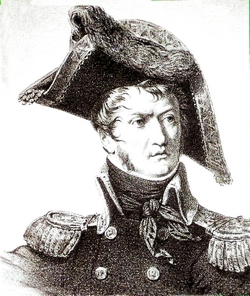 W
WGuillaume Philibert, 1st Count Duhesme was a French general during the Napoleonic Wars.
 W
WClaude François Dupré or Claude François Duprès was a French general. He first joined up in 1776 and served in the armies of the French Revolution and First French Empire. He was killed at Battle of Bailén on 21 July 1808.
 W
WGéraud Christophe Michel Duroc, 1st Duc de Frioul was a French general noted for his association with Napoleon.
 W
WJean Baptiste Eblé was a French General, Engineer and Artilleryman during the Napoleonic Wars. He is credited with saving Napoleon's Grand Army from complete destruction in 1812.
 W
WJean-Louis-Brigitte Espagne, Count d'Espagne and of the Empire was a French cavalry commander of the French Revolutionary Wars, who rose to the top military rank of General of Division and took part in the Napoleonic Wars.
 W
WClaude François Ferey, Baron de Rozengath became a division commander during the Napoleonic Wars and was killed fighting the British in Spain. In 1787 he joined the French Royal Army and became an officer in 1792. His surname is one of the Names inscribed under the Arc de Triomphe, on Column 38. At the end of the Battle of Salamanca his division held off the victorious Anglo-Portuguese, while the rest of the army escaped. He was killed in this action.
 W
WJean-Baptiste Girard, was a French soldier, général and baron d'Empire, who fought in the French Revolutionary Wars and the Napoleonic Wars.
 W
WCharles-Étienne César Gudin de La Sablonnière was a French general during the French Revolutionary Wars and Napoleonic Wars.
 W
WNicolas Bernard Guiot de Lacour led infantry and cavalry brigades during the First French Empire under Napoleon. He joined the French Royal Army in 1787 and was sent to quell the Haitian Revolution in 1791. He fought in the Army of the North starting in 1793. He was promoted to chef de brigade (colonel) in 1797 and to general of brigade in 1800. He led a cavalry brigade at Caldiero in 1805 and initially commanded the Siege of Gaeta in 1806. He fought at Abensberg, Landshut, and Eckmühl in 1809 before being fatally wounded at the Battle of Wagram on 6 July 1809. Promoted general of division on the battlefield, he died of his wounds on the 28th. GUYOT DE LACOUR is one of the names inscribed under the Arc de Triomphe on Column 11 and his bust is in the Hall of Battles at the Palace of Versailles.
 W
WJean-Joseph Ange d'Hautpoul was a French cavalry general of the Napoleonic wars. He came from an old noble family of France whose military tradition extended for several centuries.
 W
WHenri-Antoine Jardon was a French general of brigade. He served in the French Revolutionary Wars and the Napoleonic Wars. As part of the Soult's Corps, he participated in the 2nd French invasion of Portugal in 1809, and was killed at the Battle of Braga.
 W
WFrédéric Benoît Victoire Jullien was a French officer. Unlike his elder brothers, General Louis Joseph Victor Jullien de Bidon and Captain Thomas Prosper Jullien, he made his name under the Bourbon Restoration.
 W
WJean Lannes, 1st Duke of Montebello, Prince of Siewierz, was a French military commander and a Marshal of the Empire who served during both the French Revolutionary Wars and the Napoleonic Wars. He was one of Napoleon's most daring and talented generals. Napoleon once commented on Lannes: "I found him a pygmy and left him a giant". A personal friend of the emperor, he was allowed to address him with the familiar tu, as opposed to the formal vous.
 W
WPierre Belon Lapisse, Baron de Sainte-Hélène commanded an infantry division in Napoleon's armies and was fatally wounded fighting against the British in the Peninsular War. He enlisted in the French Army during the reign of Louis XVI and fought in the American Revolutionary War. Appointed an officer at the start of the French Revolutionary Wars, he rose in rank to become a general officer by 1799. From 1805 to 1807 during the Napoleonic Wars, he led a brigade in the Grande Armée at Dornbirn, Jena, Kołoząb, Golymin, and Eylau. After promotion he commanded a division in the thick of the action at Friedland in 1807.
 W
WAntoine-Charles-Louis, Comte de Lasalle was a French cavalry general during the Revolutionary and Napoleonic Wars, often called "The Hussar General". He first gained fame for his role in the Capitulation of Stettin. Over the course of his short career, he became known as a daring adventurer and was credited with many exploits. Eventually, he fought on every front and was killed at the Battle of Wagram.
 W
WLouis-Jean-Nicolas Lejoille was a French Navy officer and captain.
 W
WLouis-Michel Letort de Lorville was a French general of the Napoleonic Wars. He was made a baron de l'Empire on 9 September 1810, général de brigade on 30 January 1813, and acted as aide de camp to Napoleon himself. He fought with distinction in the first French Revolutionary Wars and became, under the First French Empire, a major in the dragoons of the Imperial Guard.
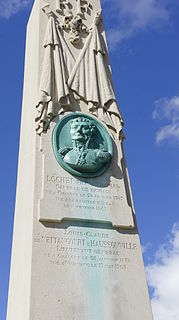 W
WPierre-Charles Lochet was a brigadier general of the Grande Armée of Napoleon Bonaparte.
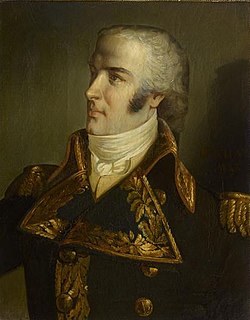 W
WCharles René Magon de Médine was a French contre-amiral killed at the battle of Trafalgar whilst commanding the ship-of-the-line Algésiras - his conduct in the battle is seen by French historians as one of the few redeeming features of that disaster, and his name appears on the Arc de Triomphe. He is also notable as a Grand Officer of the Masonic Grand Orient de France.
 W
WGénéral de brigade Charles André Merda, baron Meda was a French soldier. A National Guardsman in the Parisian National Guard from September 1789, then a gendarme from 1794, he participated in the arrest of Maximilien de Robespierre on the night of 9/10 thermidor Year II and claimed to have fired the pistol shot which broke Robespierre's jaw and hit Couthon's helper in his leg.
 W
WGeneral Claude-Étienne Michel, an officer in Napoleon's army, was second in command of the Chasseur Division of the Guard and commander of its Brigade of Middle Guard. He may be the officer who uttered the words often attributed to Pierre Cambronne "La Garde meurt et ne se rend pas" "The Guard dies, and does not surrender".
 W
WLouis Pierre, Count Montbrun, French cavalry general, served with great distinction in the cavalry arm throughout the wars of the Revolution and the Consulate, and in 1800 was appointed to command his regiment, having served therein from trooper upwards.
 W
WJean Victor Marie Moreau was a French general who helped Napoleon Bonaparte to power, but later became a rival and was banished to the United States.
 W
WDonatien-Marie-Joseph de Vimeur, vicomte de Rochambeau was a French soldier, the son of Jean-Baptiste Donatien de Vimeur, comte de Rochambeau.
 W
WFrançois Amable Ruffin was a general of division in Napoleon's First French Empire. He was mortally wounded while leading his troops against the British.
 W
WJean-Baptiste Dominique Rusca was born in the County of Nice, part of the Kingdom of Sardinia. By profession a medical doctor, he advocated the cause of the French Revolution and was expelled by the Sardinian authorities. In 1793, he treated the French sick and wounded during the Siege of Toulon and was appointed to command a sapper battalion. He later fought in the Army of Italy and the Army of the Eastern Pyrenees before returning to Italy. By the time of the Montenotte Campaign in 1796, he was a general officer leading major units. He was captured by the Austrians during the 1799 Italian campaign. After commanding garrisons for several years, he led a division in Italy during the 1809 war. He was killed in action at Soissons during the War of the Sixth Coalition. Rusca is one of the names inscribed under the Arc de Triomphe.
 W
WLouis-Vincent-Joseph Le Blond, comte de Saint-Hilaire was a French general during the Revolutionary and Napoleonic Wars.
 W
WJacques Thomas Sarrut joined the French army and became a division commander in the First French Empire of Napoleon. He led a regiment at Hohenlinden, a brigade at Jena, Bussaco, and Fuentes de Onoro, and a division at Salamanca. He was mortally wounded while leading his soldiers against the Anglo-Allied army at the Battle of Vitoria. Sarrut is one of the names inscribed under the Arc de Triomphe on Column 21.
 W
WAlexandre-Antoine Hureau de Sénarmont was a French artillery general.
 W
WEloi Charlemagne Taupin became a French soldier before the French Revolution and was killed in 1814 leading his division in battle against the British and the Spanish in southern France. After fighting in the French Revolutionary Wars, he was promoted to command an infantry regiment at the beginning of the First French Empire. He led the unit during the War of the Third Coalition in 1805. The following year he fought in the War of the Fourth Coalition. The year 1808 found him at Zaragoza in Spain where he was wounded. In 1809 he led a brigade during the War of the Fifth Coalition at Gefrees.
 W
WJean Victor Tharreau or Jean Victor Thareau, was a General of Division in the Army of the French Empire.
 W
WJean Guillaume Barthélemy Thomières was killed in action at Salamanca while commanding an Imperial French infantry division. He joined the army of the First French Republic in 1793 and fought the Spanish. He transferred to the Army of Italy in 1796 and was present at the battles of Dego, Mondovi, Lodi, Bassano, and Arcole. In 1800 he fought at Montebello and Marengo as an aide-de-camp to Claude Perrin Victor.
 W
WJean-André Valletaux was a French military commander during the French Revolutionary Wars and Napoleonic Wars, Brig-General in the Peninsular War, and Commander of the Legion of Honour.
 W
WEdmé-Martin Vandermaesen was a French general of the French Revolutionary Wars and the Napoleonic Wars. He was killed in action while leading his troops to safety after the Battle of San Marcial in the Peninsular War.